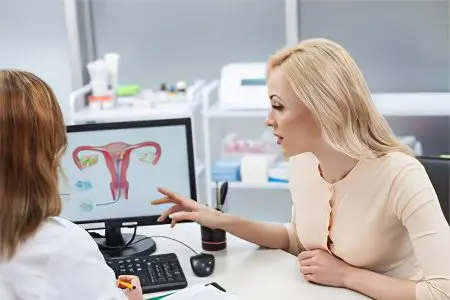Contents
- How many women with endometriosis are infertile?
- The importance of diagnostic laparoscopy in failed attempts
- Can you get pregnant with endometriosis?
- Impact of endometriosis on fertility
- When is pregnancy possible after endometriosis?
- Pregnancy after laparoscopy
- Will IVF help?
- Endometriosis during early pregnancy
Every tenth woman of childbearing age is faced with manifestations of this disease. Its causes are little known, and the complications are very severe. One of the consequences of endometriosis is infertility. Timely access to a doctor in the early stages increases a woman’s chance for a happy motherhood, even with such a difficult diagnosis.
How many women with endometriosis are infertile?
The diagnosis of “infertility” is made to women who have not become pregnant with regular unprotected sex during the year, that is, the absence of pregnancy for 3-4 months in this case is not considered critical. If the symptoms of endometriosis remained outside the diagnosis of this disease, and it has reached a late stage of its development, approximately 30-50% of women with this pathology, according to the researchers of the problem, are infertile.
The importance of diagnostic laparoscopy in failed attempts
According to rough estimates, every fourth couple treated for infertility cannot have children due to undiagnosed endometriosis in the initial stage. In women undergoing examination for infertility, endometriosis is detected 6-8 times more often than in other categories of patients. One of the reasons for this is a detailed study of the state of the reproductive organs using diagnostic laparoscopy.
Most often, these women can still be helped to remove the diagnosis of infertility, give them the opportunity to conceive and give birth to a child.
Can you get pregnant with endometriosis?

The main obstacles to conception with endometriosis:
Hormonal imbalance (excess estrogen and lack of progesterone) leads to a lack of ovulation;
The endometrium can be so affected by the disease that the fertilized egg is fixed on the cervix, causing a miscarriage;
Adhesions in the fallopian tubes prevent the egg from getting there;
The walls of the uterus, due to the germination of endometrial cells in them, become loose, do not give the embryo the opportunity to gain a foothold.
In the early stages of the disease, a woman does not lose the opportunity to become pregnant naturally, so it is too early to talk about infertility here. If natural conception is planned, it is necessary that chronic endometriosis is in remission, and not exacerbation.
If within 6 months all attempts to become pregnant have been ineffective, the help of a reproductive specialist should be taken. In the early stages of the disease (up to six months), no radical measures are taken. The exception to this rule is the age of the woman. If it approaches 35 years, it is not recommended to waste time on independent attempts to get pregnant, since this age is considered the threshold after which fertility begins to decline sharply. This means that the chances of conception decrease every day.
Impact of endometriosis on fertility

In case of failure with natural conception, the doctor prescribes a course of treatment. Many women express fears regarding the possibility of becoming pregnant after surgery and the desire to preserve the health of the child. Hormone therapy is absolutely not dangerous for the unborn fetus. But the ability to conceive can be partially or completely lost as a result of surgery.
The fact is that with a moderate or severe form of the disease, repeated removal of areas affected by endometriosis will be required. Each subsequent operation will lead to the formation of scars on the wall of the uterus, reducing the woman’s chances of becoming a mother. If the disease has taken a severe form, removal of the uterus and partial or complete removal of the ovaries is required. After hysterectomy and ovariotomy, fertility is completely lost.
With drug therapy for endometriosis, the drugs of choice are hormonal birth control pills. They do not cure the disease, but relieve its symptoms. As soon as a woman stops taking the drugs, her ability to fertilize returns.
Reasons for reduced fertility:
Formation of an ovarian cyst that prevents ovulation;
Blockage of tubal patency by endometrial cells;
The formation of adhesions and scarring in the uterus;
Adhesion due to an inflammatory process that prevents the embryo from attaching to the walls of the uterus.
When is pregnancy possible after endometriosis?
After the end of treatment, the likelihood of getting the desired pregnancy increases. However, it may take 6 months to a year for the reproductive system to fully recover. If after this pregnancy does not occur, you should undergo a complete examination under the guidance of a doctor to exclude all possible causes of infertility.
Pregnancy after laparoscopy
If there are indications in the form of adhesions in the fallopian tubes, laparoscopy is prescribed. This surgical intervention is aimed at removing the overgrown endometrium and eliminating adhesions. Although laparoscopy is very effective, the effect of it does not last long, so it is recommended to plan a pregnancy before relapse occurs.
In the absence of pregnancy within a year after this surgical intervention, it is recommended to undergo an in-depth examination to find the true cause of infertility.
Will IVF help?
If a woman uses her eggs, then during in vitro fertilization there may be problems with the implantation of the embryo. Donor eggs significantly increase the likelihood of a successful IVF outcome in a patient with endometriosis. The chances are almost equal to those of fertilization in women who do not suffer from this pathology.
Endometriosis during early pregnancy
If conception with endometriosis has occurred, and pregnancy has occurred, there is a high probability of miscarriage in the first and second trimesters. The reason for this threat is a deficiency of progesterone, which normally prevents uterine contraction and creates a favorable hormonal background. A pregnant patient with endometriosis should be constantly under the supervision of a doctor in a hospital setting.
Once the placenta completes its formation, the risk of miscarriage is greatly reduced. This disease does not affect the development of the fetus, does not cause pathologies.
If there are no symptoms of endometriosis, and pregnancy has occurred, an undiagnosed disease can lead to a habitual miscarriage of the first trimester. Therefore, pregnancy should be planned in advance, approaching conception with the highest possible level of immunity, and regularly examined.
During pregnancy, the underlying disease is not treated. The only exception is an endometrioid ovarian cyst, which can rupture. In this case, at 16-20 weeks of gestation, the formation is removed. Childbirth and breastfeeding will positively affect the course of endometriosis.
Video about whether pregnancy is possible with endometriosis:
Во-вторых, неэффективность ранее проведённого лечения – если после медикаментозной терапии женщине не удалось забеременеть.
В-третьих, возраст женщины – до 35 лет перед использованием ЭКО избирают выжидательную тактику в течение года, после этого срока назначают короткий курс гормональной терапии и производят процедуру искусственного оплодотворения.









